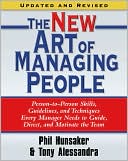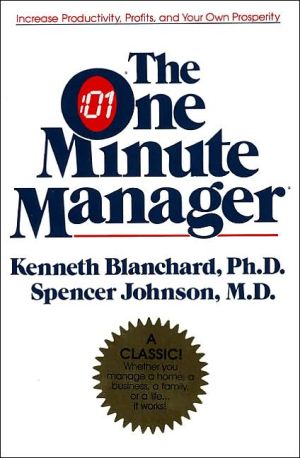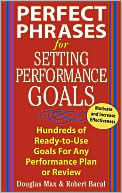The New Art of Managing People: Person-to-Person Skills, Guidelines, and Techniques Every Manager Needs to Guide, Direct, and Motivate the Team
Search in google:
When a manager establishes a friendly yet productive working atmosphere, the benefits to the whole organization are substantial. The Art of Managing People provides practical strategies, guidelines and techniques for* Developing the interpersonal skills necessary to improve relations with employees* Understanding the differences between people, and behaving accordingly* Assessing, and then improving, current working situations* Creating trust between managers and employees.Person-to-person skills are the key to developing an effective team of satisfied, energetic workers. Letting your workers express their own personalities and maximize their potentials will* Reduce stress within the work force,* Create a positive spirit throughout the company, and* Increase the organization's productivity and profitability.
ContentsPreface1 Building Productive Managerial RelationshipsThe Interactive Approach to Managing People Principles of Interactive Management Increasing Employees' On-The-Job Effectiveness Understanding People Interactive Communication Skills Constructive Manipulation What to ExpectADJUSTING EFFECTIVELY TO PERSONAL STYLE DIFFERENCES2 Learning How to LearnThe Learning Model Dimensions of Learning Individual Learning Styles Learning Modes Learning Style Types Characteristics of Learning Style Types Learning Styles and Problem Solving Guidelines for Managing the Learning Process3 Doing Unto OthersBehavioral Styles and Interpersonal Problems Unproductive Behavior Identifying Behavioral Styles Behavioral Flexibility Behavioral Styles and Interactive Management4 Deciding How to DecideThe Dimensions of Decision Style Four Basic Decision Styles Back-Up Styles Mixed Styles Characteristics of Each Decision Style Is There a "Best" Decision Style?Advantages of Each Style Problems of Each Style Coping Productively with Other Styles Applications to Integrative Management5 Analyzing Transactional StylesEgo States Transactions Strokes Life Positions Trading Stamps Use of Time Games Stopping Games Interventions TA and Interactive ManagementINTERACTIVE COMMUNICATION SKILLS6 The Art of QuestioningWhy People Ask Questions Types of Questions Questioning Strategies and Techniques7 The Power of ListeningGripes about Managers Categories of Listeners Barriers to Effective Listening The Nineteen Commandments of Power Listening Exercises to Improve Your Listening SkillsListening and Interactive Management8 Projecting the Appropriate ImageComponents of Image Image and Interactive Management9 Communicating Through Voice Tones10 Using Body Language EffectivelyInterpreting Body Language Gestures Interpreting Gesture Clusters Using Body Language11 Spatial Arrangements Say ThingsTerritory Environment Things Using Territory and Environment to Facilitate Communication Personal Space Interpersonal Space Interpersonal Space Strategies Special Arrangement Determinants Implications for Interactive Management12 How Your Use of Time TalksAccuracy Scarcity Repetition13 Making Sure with FeedbackTypes of Feedback Using Feedback EffectivelyINTERACTIVE PROBLEM-SOLVING14 Problem-Solving TogetherProblem Definition Action Planning Implementation Follow-Through15 Defining the ProblemStep 1: Establish Trust Bond Step 2: Clarify Objectives Step 3: Assess Current Situation Step 4: Identify Problems Step 5: Define and Analyze Problems Step 6: Agree on Problems to be Solved16 Developing Action PlansStep 1: Check the Trust Bond Step 2: Establish Decision-Making Criteria Step 3: Develop Action Alternatives Step 4: Evaluate Action Alternatives Step 5: Decide on an Action Plan17 Implementing ActionStep 1: Check the Trust Bond Step 2: Assign Tasks and Responsibilities Step 3: Set Up an Implementation Schedule Step 4: Reinforce Commitment and Activate18 Following ThroughStep 1: Check the Trust Bond Step 2: Establish Criteria for Success Step 3: Determine How to Measure Performance Step 4: Monitor Results Step 5: Take Corrective Action19 What Do You Do with What You've Learned?Use the Interactive Management Problem-Solving Process to Improve Your Interactive Management Skills Index








